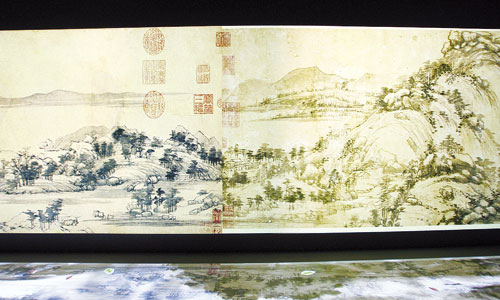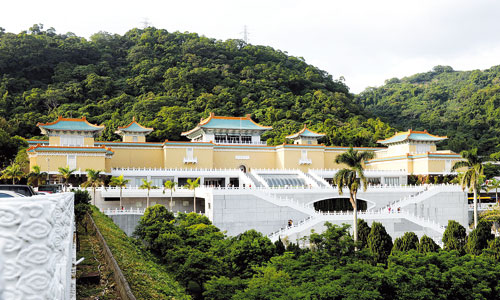A country's divided treasures
Tourists visit the Palace Museum in Beijing. Photo: CFP
More than 300 years after Jesuit priests painstakingly packed and carefully transported invaluable objects de art between the courts of French King Louis XIV and Chinese Emperor Kangxi (1654-1722), more than a dozen of them are on the move again.
Although the two monarchs lived on different continents and never met, the treasures helped them appreciate each other’s culture and art in ways that story telling and reports could hardly achieve. They symbolized their respective sovereign potency, power and pride.
This month a number of museums have come together to reunite some of those treasures that have again crossed both a continental and a political divide.
While the exhibit is focused on the historical Chinese, French connection it is also only the second time since prior to the founding of PRC that the two “palace” museums in Taipei and Beijing have shared even a few of the country’s massive and divided treasures.
The unique exhibition being held at the Palace Museum in Taiwan not only juxtaposes Chinese and French artifacts it also reunites dozens of ancient Chinese relics that haven’t been displayed together since the 1930s after they were saved from foreign invasion and separated by civil war.
Despite the turbulent and destructive first half of the 20th century, China’s ancient artifacts were never considered booty of war. After imperial rule that had been vanquished, China’s two ideologically opposed new orders remained united in understanding the necessity of protecting the country’s treasures.
During the time of strife the artifacts were not only seen as beautiful and historic objects that belonged to China and humanity. Physical possession of the nation’s masterpiece works of art and ancient treasures were symbolic of sovereignty. They remain a so-far intractable issue of nationhood.

Painted more than 600 years ago, Residence in Fuchun Mountain, is on display at the Taipei Palace Museum for the first time since its two parts reunited after it was torn more than 300 years ago. Photo: CFP
“There have only been some private or unofficial interactions between these two museums, for the sake of academic research,” said Cheng Chan-Hwa, head of public affairs of Taipei Palace Museum. The first shared exhibit between the museum in Taipei and Beijing Forbidden City’s Palace Museum was in 2009.
While each of the cities’ museums care for hundreds of thousands of artifacts some of which date back five millennia, the current exhibit features just 83 artifacts that have been stored in Taipei and 20 sets of works that belong to Beijing’s museum.
Although the number of artifacts on display is a small fraction of the total, the exhibit is an important and respectful coming together of the Chinese mainland and Taiwan. The artifacts also represent the shared epic history of a nation that remains as physically divided as its treasures.
The fascinating war story of how the treasures were protected from plunder starts in 1934 when Japanese invaders neared Beijing.
“The July 7 Incident in 1937 was a turning point,” said Deng Zongyue, a researcher at Culture and History Institution in Guizhou Province, referring to the battle against the Japanese army on the outskirts of Beijing that initiated full scale war between the two countries.
“A total of 19,557 crates of artifacts were boxed and moved south to Shanghai and then to the newly-constructed treasury within the Taoist monastery Chao Tian Gong in Nanjing,” said Liu Po, the author of Gugong Guanlan (Anecdotes in the Forbidden City).
While Beijing’s treasures were moved south, the advancing Japanese was never far behind. By 1937 the still-crated treasures had to be moved from Nanjing and were split up. Some were shipped to the city of Chongqing and some were sent as far south as Kunming in Yunnan Province.
When Japan surrendered in August 1945, China’s cultural relics were shipped back to Nanjing.
“The artifacts had been transported around the country for a decade, and although they had traveled to many cities they suffered little damage, thanks to the soldiers assigned to protect them,” said Deng.
While they country’s relics had escaped destruction and plunder at the hands of the Japanese, their journey as refugees in their own land had not neared its end.
In autumn 1948 China’s civil war once again put the nation’s treasures under threat. In its retreat from Nanjing, and later the mainland, the Kuomintang took 2,972 crates to Taiwan. The Kuomintang ordered three ships to carry almost a quarter of China’s antiquities and masterpieces, representing the cream of the entire collection.

An overview of Taipei Palace Museum. Photo: CFP
In Taipei, “the collection now numbers 682,061 items making it the premier collection of Chinese art and culture in the world,” said Chou Kung-hsin, director of Taipei Palace Museum, adding that her museum has also received many donated artifacts since it was formerly founded in the 1960s.
Beijing’s Forbidden City Palace Museum’s collection includes 1,500,000 items.
While the ownership of China’s ancient heritage remains an issue for cross-Straits negotiators to resolve, the professional curators of the two museums have “unofficially” never stopped cooperating, said Zhao Yu, the former deputy director of the China National Academy of Painting.
“Culture workers on both sides have tried their best to protect the relics… which reflect the best of a country and represent its cultural identity.”
Zhao says the value of the museums’ collections is now on par. “Although the most valuable pieces were taken to Taiwan more than a half century ago, the mainland museum has received many donated artifacts from around the world and so the value of both collections is relatively equal.
After a recently announced $654 million expansion, Taiwan’s Palace Museum’s display area will increase by five times its current size, leading some curators to compare it to the Louvre in Paris. The museum has also announced it will build a new facility in Taibao, Chiayi, which is scheduled to open in 2015.
Despite an on-going and painstaking renovation of the Forbidden City, public confidence in the Beijing Palace Museum has been shattered by a series of accidents and scandals. There have been allegations that the museum rented out part of the public buildings to an exclusive, private club. A museum technician committed the sin of sins when he dropped and shattered an ancient porcelain artifact.
Former director Zhao says he hopes to see more artifacts from Taiwan’s museum tour the mainland. “Current communications are focused on borrowing treasures for display, further development can only be achieved by improving cross-Straits relationships and ultimately unification.”